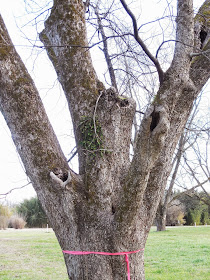This week I traveled to Georgia to attend a meeting of Pecan scientists and I was able to visit a couple of pecan orchards. Pecan trees in Georgia tend to have short trunks and a spreading canopy (photo at right). Back before the invention of pecan tree shakers, trees with a spreading canopy were preferred by the young men charged with climbing the tree to flail nuts out of the trees during harvest. But with modern tree shaking equipment, short-trunked trees are shook one major limb at a time. But having to make multiple shakes on a single tree can slow down harvest.
When I took a closer look at the large tree in the photo above, I was surprised to find so many pruning mistakes. In the photo at left, you can see several rotten spots on the tree--all the result of improper limb removal. It looks like several limbs had broken out of the tree due to
poor limb attachment angles (narrow crotches). In other cases it looks like proper
techniques for limb removal were not followed and the tree had a hard time sealing over the resulting tree wound. If this tree had been trained 50 years ago to a single (and taller) trunk with wide-angled lateral limbs many of these wood rots could have been avoided.
Later in my trip to Georgia, I came across an orchard with the largest collection of poorly trained trees I have ever seen.
 |
| Split trunk, the result of a narrow crotch |
The photo at left and the ones posted below serve as just a few examples of trees in this orchard that will present the grower with long term tree structural problems. To avoid misshaped trees like the ones pictured here, make sure you start training your pecan trees at a young age. It is much easier to correct poor tree form with a pair of hand clippers than it is to repair broken trees with a chainsaw.
For detailed instructions on tree training go to my blog series entitled "
Training young trees".
 |
| Top split out at bark inclusion |
 |
| No central leader |
 |
| Split out limb scar, weak central leader |
 |
| Narrow crotch may lead to split trunk in the future | |
 |
| Low limbs arising from the same spot on trunk |
|







